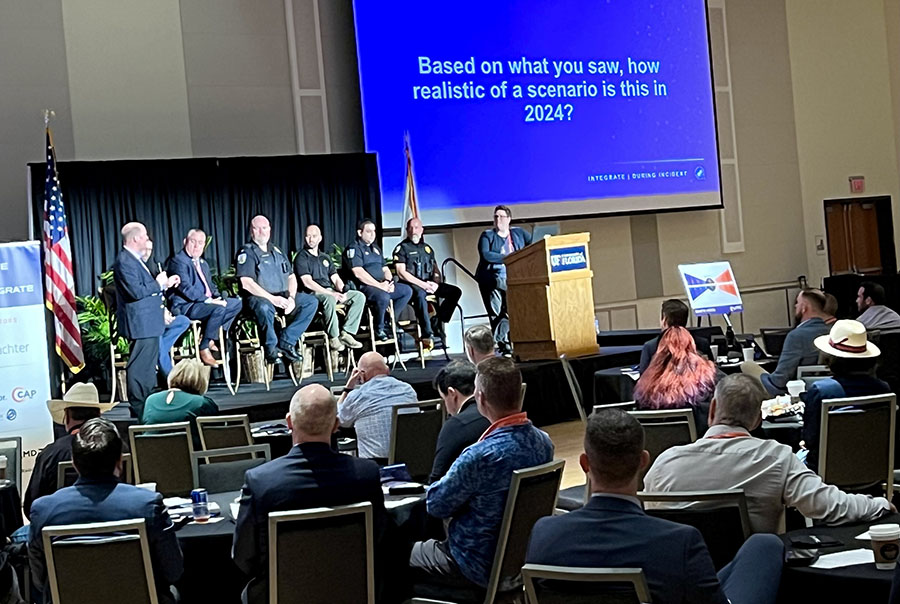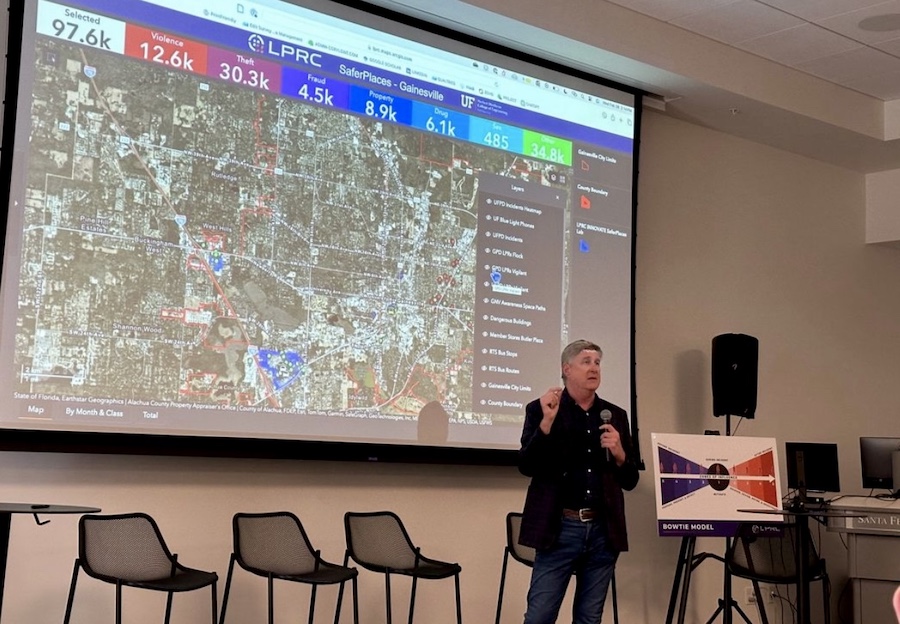Retail industry leaders from 47 corporations across the nation recently convened at the University of Florida to delve into strategies to combat the growing challenges from theft, fraud, and violence in retail spaces.
The event, Integrate Summit held Feb. 29 at UF’s Reitz Union and hosted by the Loss Prevention Research Council, focused on the threat of an active shooter incident.
For more than 20 years, some of the country’s largest retailers have looked to the LPRC and its affiliated UF researchers to help stop crime in their stores through research-based trial and testing. While their efforts initially focused on shoplifting and shrink losses, recent attention has shifted toward preventing violent crimes in retail spaces.
“LPRC is the vanguard of asset protection in the retail industry,” said Dave Johnston, vice president of asset protection and retail operations for the National Retail Federation.
Each year, the LPRC board of advisors meet in February to finalize and approve the research priorities for the coming year, said Read Hayes, director and founder of the LPRC and a research scientist at UF’s Herbert Wertheim College of Engineering.
“We reviewed how various technology solutions integrate with mapping and shared intelligence to identify criminal acts, including detecting crime attempts before they become physical,” Hayes said.
More than 150 emergency, law enforcement, technology, and retail corporate executives, including some who have firsthand experience in handling mass shooting situations, reviewed a pre-recorded, highly realistic armed assailant exercise staged just weeks earlier in a UF building.
“The exercise helps us determine things we can do to build better partnerships among our peers as well as with law enforcement and to look forward to how technology can help us prevent, mitigate, and even recover faster,” Johnston said.

More than 150 emergency, law enforcement, technology, and retail corporate executives reviewed an armed assailant exercise staged just weeks earlier in a UF building
The group watched the simulated active shooter event, which showed a man with a loaded firearm gain access to the Hub at UF Innovate on Southwest Second Avenue, five blocks east of the UF campus. Acting as a disgruntled former employee, the faux assailant went to the second floor and began firing his weapon in a mock store, which serves as a learning lab for UF’s SaferPlaces Lab and the LPRC’s 96 corporate retail members.
Participants, including officers from the University of Florida Police Department, the Gainesville Police Department and Alachua County Sherriff’s Office, worked together to locate and neutralize the threat while ensuring the safety of those within the building. The scenario ended with the attacker taking his own life.
The exercise demonstrated what currently occurs when no early detection technologies and protocols are used, Hayes said. However, a number of these systems were in place to inspire discussion and future R&D efforts. They included potential threat identifiers like a license plate reader and cameras in the parking area and building interior. With information from the former employee’s record and photo ID, these systems could have set off early-detection alerts to a store manager, who then, if concerned, could secure entry doors and call for police protection. Existing cameras on the premises could also be equipped with weapon and verbal-threat-phrase detection, setting off an alarm to management when a gun is present or someone is making threats.
Throughout the meeting, panel members led discussions and analyses of what they witnessed on the video. Speakers included solution providers with LPRC, asset protection specialists for national companies like Kroger, Verizon and American Freight, law enforcement officials who participated in the reenactment, a Broward County Sheriff’s sergeant who responded to the Parkland high school shooting, and FBI, UF and Santa Fe College threat assessment officials.
“The whole point of today is to bring industry leaders together to identify how we can leverage technology to improve the experience from a safety perspective for our employees and customers,” said Michael Currier, vice president for physical security operations at Verizon. “What was eye-opening for me is retailers need to standardize the processes we follow when an event takes place. That consistency would provide law enforcement with a common operating platform to work from when responding. Right now, every retailer is doing things a little differently.”
Currier said a good example of the inconsistencies is when officers get to a scene, and they must determine who has the keys or access cards to get into the building.
“If retailers followed one standard practice for storing access keys and vital information for police, it would eliminate a lot of confusion and accelerate law enforcement’s response time, saving lives,” Currier said.

Read Hayes, director and founder of the LPRC and a research scientist at UF’s Herbert Wertheim College of Engineering
The active shooter re-creation was also analyzed from a pre-event perspective for finding prevention strategies, as earlier-received threats picked up on social media were analyzed by five threat teams, including from two retail corporations, the FBI, UF and Santa Fe College. To end the day, the group examined ways to better recover from traumatic events.
“It was a productive meeting with some of the industry’s most influential retail loss prevention leaders around the table,” said UF and LPRC’s Hayes. “We identified technology and protocol R&D priorities for the coming year. Our team will put together a package that retailers and others can use to help develop their plans and training initiatives.”
Tom Arigi, divisional vice president of asset protection for American Freight, has worked with the LPRC for over 15 years while working in his field for a handful of large retailers. He estimates that in the last six years, he’s experienced six active-shooter events with multiple casualties.